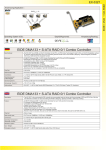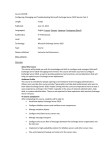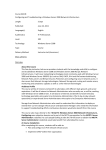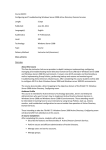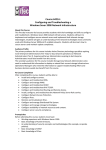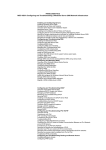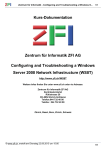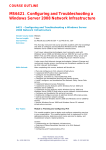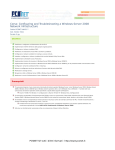Download M6421A Configuring and Troubleshooting a Windows Server 2008
Transcript
Looking at Training Differently...... M6421A Configuring and Troubleshooting a Windows Server 2008 Network Infrastructure Course 6421A: Configuring and Troubleshooting a Windows Server 2008 Network Infrastructure Length: 5 Day(s) Published: May 29, 2008 Language(s): English Audience(s): IT Professionals Level: 200 Technology: Windows Server 2008 Type: Course Delivery Method: Instructor-led (classroom) About this Course This five-day instructor-led course provides students with the knowledge and skills to configure and troubleshoot a Windows Sever 2008 network infrastructure. Students will learn to implement and configure secure network access and implement fault tolerant storage technologies. Students will gain an understanding of the network technologies most commonly used with Windows Server 2008 and IP-enabled networks. Students will also learn how to secure servers and maintain update compliance. Audience Profile The primary audience for this course includes Active Directory technology specialists aspiring to be Enterprise Administrators (Tier 4 day-to-day network operations) or Network Administrators (Tier 2). Experienced Server Administrators aspiring to be Enterprise Administrators would also benefit from this course. The secondary audience for this course includes Storage Area Network Administrators who need to understand this information to deploy or extend their current storage infrastructure. Operations Managers who need this information to support troubleshooting efforts and business decisions would also benefit from this course. At Course Completion After completing this course, students will be able to: • Install and configure servers. • Configure and troubleshoot DNS. • Configure and manage WINS. • Configure and troubleshoot DHCP. • Configure and troubleshoot IPv6 TCP/IP. • Configure and troubleshoot Routing and Remote Access. For more information, or to book your course, please call Sense Training on 0870 4296445 Or visit our web site –www.sensetraining.co.uk Looking at Training Differently...... • Install, configure, and troubleshoot the Network Policy Server Role service. • Configure Network Access Protection. • Configure IPsec. • Monitor and troubleshoot IPsec. • Configure and manage Distributed File System. • Configure and manage storage technologies. • Configure availability of network resources and content. • Configure server security compliance. Course OutlineModule 1: Installing and Configuring Servers This module explains how to identify the appropriate usage scenario and installation type for a server and then install and configure appropriate server roles and features. Lessons • Installing Windows Server 2008 • Managing Server Roles and Features • Overview of the Server Core Installation Option Lab : Installing and Configuring Servers and Server Roles • Exercise 1: Identifying Server Types • Exercise 2: Installing and Configuring Server Roles and Features • Exercise 3: Configuring Server Core and Performing Basic Management Tasks After completing this module, students will be able to: • Identify the system requirements and process for installing Windows Server 2008. • Describe the difference between server roles and features. • Describe the benefits of and roles supported by a Server Core installation. Module 2: Configuring and Troubleshooting DNS This module explains how to configure, manage and troubleshoot DNS server and zone properties to be used in a secure environment. Lessons • Installing the DNS Server Role • Configuring the DNS Server Role • Configuring DNS Zones • Configuring DNS Zone Transfers • Managing and Troubleshooting DNS Lab : Configuring and Verifying a DNS Solution For more information, or to book your course, please call Sense Training on 0870 4296445 Or visit our web site –www.sensetraining.co.uk Looking at Training Differently...... • Exercise 1: Configuring a DNS Infrastructure • Exercise 2: Monitoring and Troubleshooting DNS After completing this module, students will be able to: • Install the DNS Server role. • Configure the DNS Server role to support various query types. • Configure DNS zones. • Configure DNS zone transfers. • Manage DNS zone records and troubleshoot DNS using various tools. Module 3: Configuring and Managing WINS This module explains how to configure, manage and troubleshoot WINS servers. Lessons • Overview of the Windows Internet Name Service • Managing the WINS Server • Configuring WINS Replication • Migrating from WINS to DNS Lab : Configuring a WINS Infrastructu • Exercise 1: Installing WINS • Exercise 2: Configuring WINS Burst Handling • Exercise 3: Configuring WINS Replication • Exercise 4: Migrating from WINS to DNS After completing this module, students will be able to: • Install and configure the Windows Internet Name Service. • Manage WINS client records. • Configure and manage WINS replication. • Migrate a WINS infrastructure to DNS. Module 4: Configuring and Troubleshooting DHCP This module explains how to configure, manage and troubleshoot a DHCP environment supporting an IPV4 infrastructure. Lessons • Overview of the DHCP Server Role • Configuring DHCP Scopes and Options • Managing a DHCP Database For more information, or to book your course, please call Sense Training on 0870 4296445 Or visit our web site –www.sensetraining.co.uk Looking at Training Differently...... • Monitoring and Troubleshooting DHCP • Securing DHCP Lab : Configuring and Troubleshooting the DHCP Server Role • Exercise 1: Installing and Authorizing the DHCP Server Role • Exercise 2: Configuring a DHCP Scope • Exercise 3: Troubleshooting Common DHCP Issues After completing this module, students will be able to: • Describe how DHCP works. • Configure DHCP scopes and options. • Manage a DHCP database. • Monitor and troubleshoot DHCP. • Secure DHCP. Module 5: Configuring and Troubleshooting IPv6 TCP/IP This module explains how to configure and troubleshoot static and dynamic IPv6 addresses, including subnet prefix lengths, gateways and DNS servers. Lessons • Overview of IPv6 • Coexistence with IPv6 • IPv6 Tunneling Technologies • Transitioning from IPv4 to IPv6 • Troubleshooting IPv6 Lab : Lab A: Configuring an ISATAP Router • • Exercise 1: Configuring a New IPv6 Network and Client Exercise 2: Configuring an ISATAP Router to Enable Communication Between an IPv4 Network and an IPv6 Network Lab : Lab B: Converting the Network • Exercise 1: Transitioning to an IPv6-Only Network After completing this module, students will be able to: • Describe the benefits and considerations of IPv6. • Describe how IPv6 can coexist with IPv4 environments. • Describe IPv6 tunneling technologies used to interoperate with IPv4 networks. • Describe the process used to migrate from IPv4 to IPv6. • Troubleshoot IPv6 connectivity. For more information, or to book your course, please call Sense Training on 0870 4296445 Or visit our web site –www.sensetraining.co.uk Looking at Training Differently...... Module 6: Configuring and Troubleshooting Routing and Remote Access This module explains how to configure and troubleshoot Routing and Remote Access Services. Lessons • Configuring Network Access • Configuring VPN Access • Overview of Network Policies • Overview of the Connection Manager Administration Kit • Troubleshooting Routing and Remote Access Lab : Configuring and Managing Network Access • Exercise 1: Configuring Routing and Remote Access as a VPN Remote Access Solution • Exercise 2: Configuring a Custom Network Policy • Exercise 3: Configuring Logging • Exercise 4: Configuring a Connection Profile After completing this module, students will be able to: • Install and configure the Routing and Remote Access service. • Configure VPN access. • Configure network policies. • Configure a connection profile using the Connection Manager Administration Kit. • Troubleshoot Routing and Remote Access. Module 7: Installing, Configuring, and Troubleshooting the Network Policy Server Role Service This module explains how to install, configure and troubleshoot the Network Policy Server Role service. Lessons • Installing and Configuring a Network Policy Server • Configuring RADIUS Clients and Servers • NPS Authentication Methods • Monitoring and Troubleshooting a Network Policy Server Lab : Configuring and Managing Network Policy Server • Exercise 1: Installing and Configuring the Network Policy Server Role Service • Exercise 2: Configuring a RADIUS Client • Exercise 3: Configuring Certificate Auto-Enrollment After completing this module, students will be able to: For more information, or to book your course, please call Sense Training on 0870 4296445 Or visit our web site –www.sensetraining.co.uk Looking at Training Differently...... • Install and configure the Network Policy Server role. • Configure a RADIUS client and server. • Describe NPS authentication methods. • Monitor and troubleshoot a Network Policy server. Module 8: Configuring Network Access Protection This module explains how to configure and manage NAP for DHCP, VPN, and 802.1X. Lessons • Overview of Network Access Protection • How NAP Works • Configuring NAP • Monitoring and Troubleshooting NAP Lab : Configuring NAP for DHCP and VPN • Exercise 1: Configuring NAP for DHCP Clients • Exercise 2: Configuring NAP for VPN Clients After completing this module, students will be able to: • Describe the benefits and uses of NAP. • Describe how NAP works in various access scenarios. • Configure NAP. • Monitor and troubleshoot NAP. Module 9: Configuring IPsec This module explains how to configure and test IPsec. Lessons • Overview of IPsec • Configuring Connection Security Rules • Configuring IPsec NAP Enforcement Lab : Configuring IPsec NAP Enforcement • Exercise 1: Preparing the Network Environment for IPsec NAP Enforcement • Exercise 2: Configuring and Testing IPsec NAP Enforcement After completing this module, students will be able to: • Describe the benefits and uses of IPsec. • Configure Connection Security rules. • Configure IPsec NAP enforcement. Module 10: Monitoring and Troubleshooting IPsec For more information, or to book your course, please call Sense Training on 0870 4296445 Or visit our web site –www.sensetraining.co.uk Looking at Training Differently...... This module explains how to monitor and troubleshoot IPsec. Lessons • Monitoring IPsec Activity • Troubleshooting IPsec Lab : Monitoring and Troubleshooting IPsec • Exercise 1: Monitoring IPSec Connectivity • Exercise 2: Configuring Connection Security • Exercise 3: Troubleshooting IPSec After completing this module, students will be able to: • Monitor IPsec activity. • Troubleshoot IPsec. Module 11: Configuring and Managing Distributed File System This module explains how to configure and manage Distributed File System. Lessons • DFS Overview • Configuring DFS Namespaces • Configuring DFS Replication Lab : Configuring DFS • Exercise 1: Installing the Distributed File System Role Service • Exercise 2: Creating a DFS Namespace • Exercise 3: Configuring Folder Targets and Folder Replication • Exercise 4: Viewing Diagnostic Reports for Replicated Folders After completing this module, students will be able to: • Describe the Distributed File System. • Manage DFS namespaces. • Configure DFS replication. Module 12: Configuring and Managing Storage Technologies This module explains how to configure and troubleshoot file system storage technologies included with Windows Server 2008. Lessons • Windows Server 2008 Storage Management Overview • Managing Storage Using File Server Resource Manager • Configuring Quota Management • Implementing File Screening For more information, or to book your course, please call Sense Training on 0870 4296445 Or visit our web site –www.sensetraining.co.uk Looking at Training Differently...... • Managing Storage Reports Lab : Configuring and Managing Storage Technologies • Exercise 1: Installing the FSRM Role Service • Exercise 2: Configuring Storage Quotas • Exercise 3: Configuring File Screening • Exercise 4: Generating Storage Reports After completing this module, students will be able to: • Describe storage management solutions included in Windows Server 2008. • Manage storage using File Server Resource Manager (FSRM). • Configure quota management using FSRM. • Implement file screening using FSRM. • Manage storage reports. Module 13: Configuring Availability of Network Resources and Content This module explains how to describe and configure backup and recovery methods. Lessons • Backing Up Data • Configuring Shadow Copies • Providing Server and Service Availability Lab : Configuring Availability of Network Resources • Exercise 1: Configuring Windows Server Backup and Restore • Exercise 2: Configuring Shadow Copying • Exercise 3:Configuring Network Load Balancing After completing this module, students will be able to: • Back up data. • Configure shadow copies. • Provide server and service availability. Module 14: Configuring Server Security Compliance This module explains how to configure and analyze server security and security update compliance. Lessons • Securing a Windows Infrastructure • Using Security Templates to Secure Servers • Configuring an Audit Policy For more information, or to book your course, please call Sense Training on 0870 4296445 Or visit our web site –www.sensetraining.co.uk Looking at Training Differently...... • Overview of Windows Sever Update Services • Managing WSUS Lab : Configuring Server Security Compliance • Exercise 1: Configuring and Analyzing Security • Exercise 2: Analyzing Security Templates • Exercise 3: Configuring Windows Software Update Services After completing this module, students will be able to: • Secure a server role within a Windows infrastructure. • Secure servers using security templates. • Configure an audit policy. • Describe the use of Windows Server Update Services. • Manage updates using WSUS. For more information, or to book your course, please call Sense Training on 0870 4296445 Or visit our web site –www.sensetraining.co.uk













